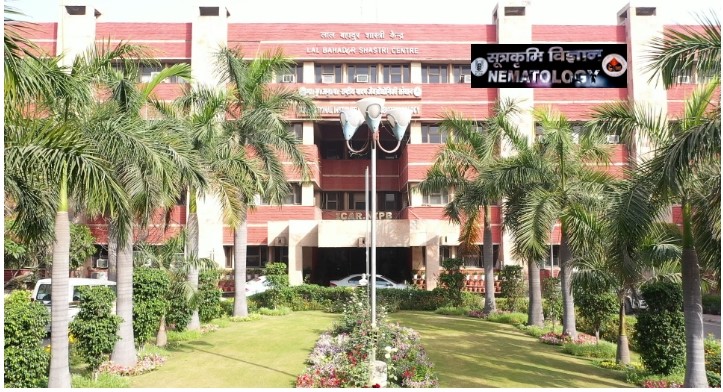भा.कृ.अ.प. - भारतीय कृषि अनुसंधान संस्थान | ICAR-Indian Agricultural Research Institute
| हिन्दी | || || |
भा.कृ.अ.प. - भारतीय कृषि अनुसंधान संस्थान | ICAR-Indian Agricultural Research Institute
| हिन्दी | || || |

The Division of Nematology is mandated to work on nematodes, commonly called as roundworms, eelworms or threadworms. They are the most numerous multi-cellular organisms inhabiting different habitats and belong to diverse trophic groups. Plant parasitic nematodes also inflict indirect damage to crops by pre-disposing plants to other co-inhabiting pathogenic bacteria, fungi, pathogens etc. They are an important biotic stress for the successful cultivation of field and horticultural crops. Among these, root-knot nematode (Meloidogyne sp.), cyst forming nematodes (Heterodera sp.,Globodera sp.), reniform nematode (Rotylenchulus reniformis), lesion nematode (Pratylenchus sp.), burrowing nematode (Radopholus similis), and leaf and bud nematode (Aphelenchoides besseyi) are economically important nematodes. Some of the important nematode diseases such as molya disease of wheat and barley, ear-cockle and tundu diseases of wheat and barley are prevalent in Punjab, Himachal Pradesh, Rajasthan and Haryana. Slow decline of citrus due to Tylenchulus semipenetrans in citrus growing areas and spreading decline of banana due to Radopholus similis in southern part of the country are also key-nematode pests. In the recent past, rice root-knot nematode (Meloidogyne graminicola) infecting rice both under low-land and upland rice has become a serious nematode problem throughout the rice growing belt of the country. Phytonematode induced plant diseases often go unaware amongst the farming community due to the hidden mode of life of these soil-borne unseen enemies of the crops. In the present scenario, the nematode problems are increasing due to adoption of multiple cropping system and intensive cultivation of crops. At least 10 phytonematodes damage the crops and have been found to be responsible for quantitative and qualitative yield losses all over the world. In India, the national loss due to plant parasitic nematodes in 24 different crops in monetary terms has been worked out to the tune of Rs.21,000 million.
However, there are some beneficial and useful nematodes which are potential biocontrol agents and have been successfully utilized as entomopathogenic nematodes (EPNs) for the management of insect pests of crops. These EPNs along with their bacterial symbionts kill the insect-hosts within 24-48 hours. Nowadays EPNs have been considered as an excellent candidate for the biological control of insect-pests of crops. Saprozoic nematodes which are non-pathogenic and free-living in nature, play a vital role in the rhizosphere management by regulating the populations of other microorganisms including phytonematodes and contribute to soil health by nutrient mineralization and soil processes. Caenorhabditis elegans was the first metazoan to get sequenced and has served as a model organism for the modern researches in the area of molecular and developmental biology.
The Division of Nematology, formally came into existence on 31st December, 1966 after merger of the two separately existing Nematology units, functioning in the Division of Entomology and Division of Mycology and Plant Pathology. Dr. A.R. Seshadri, a renowned nematologist of international repute was appointed as the first Head, Division of Nematology, and Dr. S.K. Prasad as the first Professor of the Division. All India Coordinated Research Project on Nematodes in Cropping Systems is also operating with the Project Coordinating Cell, Headquarter at the Division of Nematology, IARI, New Delhi.
